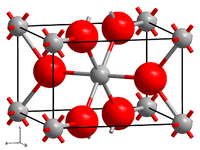Molybdenum (IV) oxide
| Crystal structure | |||||||||||||||||||
|---|---|---|---|---|---|---|---|---|---|---|---|---|---|---|---|---|---|---|---|

|
|||||||||||||||||||
| __ Mo 4+ __ O 2− | |||||||||||||||||||
| Crystal system |
monoclinic |
||||||||||||||||||
| Space group |
P 2 1 / c |
||||||||||||||||||
| Lattice parameters |
a = 558.4 pm, b = 484.2 pm, c = 560.8 pm, β = 120.59 ° |
||||||||||||||||||
| General | |||||||||||||||||||
| Surname | Molybdenum (IV) oxide | ||||||||||||||||||
| other names |
Molybdenum dioxide |
||||||||||||||||||
| Ratio formula | MoO 2 | ||||||||||||||||||
| Brief description |
red-brown, odorless solid |
||||||||||||||||||
| External identifiers / databases | |||||||||||||||||||
|
|||||||||||||||||||
| properties | |||||||||||||||||||
| Molar mass | 127.94 g mol −1 | ||||||||||||||||||
| Physical state |
firmly |
||||||||||||||||||
| density |
6.47 g cm −3 |
||||||||||||||||||
| Melting point |
1100 ° C (decomposition) |
||||||||||||||||||
| solubility |
poor in water (1.4 g l −1 at 20 ° C) |
||||||||||||||||||
| safety instructions | |||||||||||||||||||
|
|||||||||||||||||||
| As far as possible and customary, SI units are used. Unless otherwise noted, the data given apply to standard conditions . | |||||||||||||||||||
Molybdenum (IV) oxide is a chemical compound from the group of oxides .
Occurrence
Molybdenum (IV) oxide occurs very rarely naturally as the mineral tugarinovite .
Extraction and presentation
Molybdenum (IV) oxide can be obtained by reducing molybdenum (VI) oxide with hydrogen , ammonia or elemental molybdenum above a temperature of 470 ° C:
Larger single crystals can be obtained by chemical transport of polycrystalline molybdenum (IV) oxide with iodine in a temperature gradient of 900 to 700 ° C.
properties
Molybdenum (IV) oxide is a brown-violet solid that is sparingly soluble in water. It has a monoclinic crystal structure with the space group P 2 1 / c (space group no. 14) (a = 558.4 pm, b = 484.2 pm, c = 560.8 pm, β = 120.59 °). Very finely divided powder is self-igniting in air.
use
Molybdenum (IV) oxide can be used as a catalyst for the dehydrogenation of alcohols.
Individual evidence
- ↑ a b c d e f Entry for CAS no. 18868-43-4 in the GESTIS substance database of the IFA , accessed on December 11, 2012 (JavaScript required)
- ↑ WebElements: molybdenum dioxide
- ↑ Mineral Atlas: Tugarinovite
- ↑ Cotton, F. Albert; Wilkinson, Geoffrey; Murillo, Carlos A .; Bochmann, Manfred (1999), Advanced Inorganic Chemistry (6th ed.), New York: Wiley-Interscience, ISBN 0-471-19957-5
- ^ AF Holleman , E. Wiberg , N. Wiberg : Textbook of Inorganic Chemistry . 91st – 100th, improved and greatly expanded edition. Walter de Gruyter, Berlin 1985, ISBN 3-11-007511-3 , p. 1100.
- ↑ a b Georg Brauer (Ed.) U. a .: Handbook of Preparative Inorganic Chemistry. 3rd, revised edition. Volume III, Ferdinand Enke, Stuttgart 1981, ISBN 3-432-87823-0 , p. 1542.
- ↑ AA Balandin and ID Rozhdestvenskaya, Russian Chemical Bulletin, 8, 11, (1959), 1573 doi : 10.1007 / BF00914749

